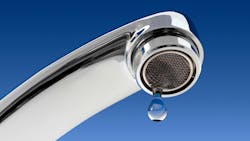As the construction industry evolves, sustainability has become a central focus, especially regarding water efficiency. For professionals in plumbing, hydronic, and mechanical systems, integrating sustainable practices is not only environmentally responsible but also economically beneficial. Water conservation and resource management in construction projects are best accomplished by key strategies and technologies.
Water Conservation Techniques
Water conservation is paramount in sustainable construction, playing a vital role in the long-term viability of buildings and infrastructure. Implementing efficient water management practices reduces consumption, lowers operational costs, extends system lifespans, and minimizes environmental impact by preserving local water resources, reducing energy demand for treatment and pumping, and supporting regulatory compliance.
Low-Flow Fixtures and Appliances — Installing low-flow toilets, faucets, and showerheads can significantly reduce water usage without compromising performance. These fixtures are designed to use less water per use, contributing to overall conservation efforts.
Rainwater Harvesting Systems — Collecting and storing rainwater for non-potable uses, such as irrigation and toilet flushing, decreases reliance on municipal water supplies. This practice not only conserves water but also reduces stormwater runoff.
Greywater Recycling — Reusing water from sinks, showers, and laundry for landscape irrigation or toilet flushing can substantially cut down on freshwater demand. Greywater systems must be properly designed and maintained to ensure safety and effectiveness.
Advanced Leak Detection Technologies
Undetected leaks can lead to significant water loss, structural damage, and increased utility costs over time. Advanced leak detection technologies are essential for maintaining water efficiency, preserving system integrity, improving response times, reducing environmental impact, and ensuring the long-term performance of plumbing, hydronic, and mechanical systems across both residential and commercial construction projects.
Smart Water Meters — These devices provide real-time monitoring of water usage, allowing for the early detection of leaks and anomalies. By identifying issues promptly, repairs can be made before substantial water loss occurs.
Acoustic Leak Detectors — Utilizing sound sensors, these detectors can identify leaks within walls or underground pipes, facilitating timely maintenance and preventing extensive damage.
Infrared Thermography — This technology detects temperature variations caused by water leaks, enabling noninvasive inspections and accurate pinpointing of problem areas.
Innovative Plumbing Solutions
Advancements in plumbing design contribute significantly to sustainability in construction, playing a vital role in how buildings conserve water, reduce energy consumption, and minimize environmental impact. From high-efficiency fixtures to integrated leak detection systems and smart water management tools, today’s plumbing solutions are engineered to support greener, more resource-conscious built environments.
Pipe Sizing Optimization — Properly sizing pipes reduces material usage and minimizes water stagnation, which can lead to bacterial growth. Optimized pipe sizing ensures efficient water flow and reduces the risk of contamination.
Modular Plumbing Systems — Prefabricated plumbing modules streamline installation, reduce waste, and enhance quality control. These systems allow for precise material usage and can be easily adapted for future modifications.
Pressure-Reducing Valves — Installing these valves helps maintain optimal water pressure, preventing pipe bursts and reducing water waste. They are particularly useful in high-rise buildings where pressure variations are common.
Soil Stabilization Services
Soil stabilization is a critical aspect of sustainable construction, ensuring the longevity and integrity of structures across diverse terrains and environmental conditions. Effective soil stabilization services contribute to water efficiency by preventing erosion, supporting vegetation growth, controlling runoff, and maintaining proper drainage systems that help preserve surrounding ecosystems.
Use of Geotextiles — These permeable fabrics reinforce soil, improve stability, and promote proper water flow, reducing the risk of erosion and sedimentation.
Chemical Stabilization — Applying chemical agents, such as lime or cement, enhances soil strength and durability, providing a stable foundation for construction projects.
Vegetative Cover — Planting vegetation on slopes and embankments stabilizes soil through root systems, reduces runoff, and improves water infiltration.
Integrating Sustainable Practices
For plumbing, hydronic, and mechanical systems professionals, adopting sustainable practices involves a holistic approach that goes beyond basic compliance. It requires thoughtful system design, smart material selection, ongoing performance monitoring, and a commitment to integrating environmentally responsible technologies that reduce waste, conserve energy, and support long-term resource efficiency across all phases of construction and building operation.
-
Design Integration: Collaborate with architects and engineers to incorporate water-efficient systems from the project's inception. Early involvement allows plumbing and mechanical systems to be optimized for sustainability without costly redesigns.
-
Material Selection: Choose environmentally friendly materials that offer durability and recyclability. Prioritizing low-impact, high-performance materials can also reduce maintenance needs and extend system lifespans.
-
Continuous Education: Stay informed about emerging technologies and best practices in sustainable construction. Regular training empowers professionals to make smarter choices that align with evolving environmental goals.
-
Regulatory Compliance: Ensure all systems meet or exceed local and national sustainability standards. Proactive compliance can streamline inspections and qualify projects for green building certifications or incentives.
Closing the Loop: Building a Greener Future Through Smarter Systems and Soil
Sustainability in construction isn’t a one-time decision—it’s an ongoing commitment that depends on the expertise and engagement of plumbing, hydronic, and mechanical systems professionals. By embracing smart water conservation strategies, using innovative technology, adopting forward-thinking plumbing designs, and integrating effective soil stabilization services, these professionals can play a powerful role in protecting resources and supporting long-term environmental health. These approaches bring real value through lower costs, better system performance, and greater durability across every phase of a construction project.
About the Author
Alex Martini
Alex Martini is Marketing Manager for Rock Solid Stabilization & Reclamation, Inc., a sustainable reconstruction company, specializing in soil modification and pavement preservation. He has 10 years of experience in the industry and focuses on digital content and social media to promote best practices within the stabilization industry while co-branding with clients and vendors alike.
